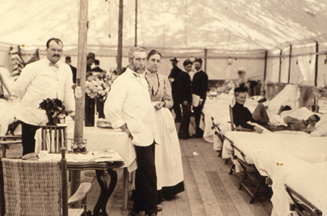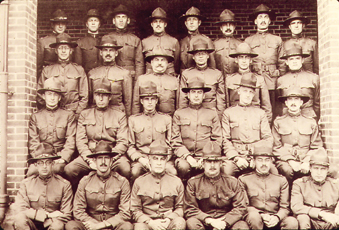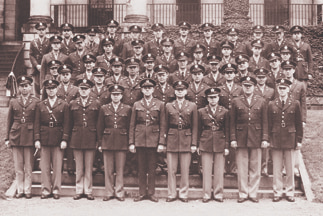Mass General on the Front Lines
Throughout its history, Massachusetts General Hospital has had the privilege of providing care for members of the military during wartime, and war has inevitably influenced and shaped the hospital and the care it provides.
The following timeline highlights some of the connections between specific wars and Massachusetts General Hospital—from the relative of a hospital founder who fought in the Revolution to the recent establishment of the Red Sox Foundation and Massachusetts General Hospital Home Base Program.
American Revolution (1775 to 1783)
Maj. Gen. Joseph Warren, MD—uncle of John Collins Warren, MD, one of the Mass General founders—was killed while fighting in the Battle of Bunker Hill. Before his death, Warren had helped push for smallpox inoculations among soldiers in the Continental Army.
Mexican-American War (1846 to 1848)
The first public demonstration of ether as a surgical anesthetic took place at the Mass General on Oct. 16, 1846. It was used by the U.S. Army and Navy the following spring and became part of the issued supplies.
Civil War (1861 to 1865)

Henry Jacob Bigelow, MD, a Mass General surgeon, presented a series of lectures for 200 Mass General assistant surgeons to help prepare them to serve as military surgeons. The training was considered ahead of its time, as an army general helped to instruct surgeons on types of wounds they could expect to treat.
During the Civil War, Mass General admitted soldiers free of charge.
Spanish-American War (1898)
Mass General staff cared for Massachusetts volunteer soldiers in tent wards that were set up on the Bulfinch Lawn.
World War I (1914 to 1918)

On Dec. 6, 1917, a munitions ship exploded in Halifax Harbour in Nova Scotia, nearly destroying the city. A Mass General contingency joined the relief train that Boston sent to aid the city. Since 1917, Nova Scotia has sent the City of Boston a large tree each Christmas in recognition of this aid.
In May 1917, U.S. Army Base Hospital No. 6, a medical/surgical unit of Mass General physicians and nurses, was activated under the command of Col. Frederic A. Washburn, MD, director of the hospital. The unit would later be reactivated by the government during World War II and would be called the 6th General Hospital.
Stanley Cobb, MD, the first chief of psychiatry at Mass General, researched “shell shock,” “soldier’s heart” and “neurocirculatory asthenia”—phrases all used to describe what is now called post-traumatic stress disorder (PTSD).
World War II (1939 to 1945)
In 1943, Harvard University’s particle accelerator, or “cyclotron,” used in atomic research, was sold to the U.S. government for research leading to the creation of the first atomic bomb. The replacement unit, used for physics research, was used by Mass General physicians to treat certain tumors. In 2001, the hospital opened what is now known as the Francis H. Burr Proton Therapy Center, which offers targeted treatments to destroy cancer cells using a cyclotron.

Beginning in 1941, the hospital developed advanced triage techniques for large-scale civilian disasters, such as an unexpected U-boat attack. This preparation ultimately enabled Mass General to care for the victims of the Cocoanut Grove fire in 1942.
Korean War (1950 to 1953 Korean War Armistice)
Immediately after the war broke out, Mass General set up an Emergency Defense Committee to prepare the hospital and city for a potential attack. It was directed by Horatio Rogers, MD, a Mass General surgeon and the 6th General Hospital’s chief of surgery during World War II.
Vietnam War (1955 to 1975)
Mass General research made long-term storage of blood practical, lengthening the number of days donor blood could be stored. This allowed for the transport of blood to soldiers halfway across the world.
Afghanistan and Iraq Wars (2001 to Present)
The Red Sox Foundation and Massachusetts General Hospital Home Base Program was established in 2009 to provide PTSD and traumatic brain injury services for veterans of the Afghanistan and Iraq wars and their families.
